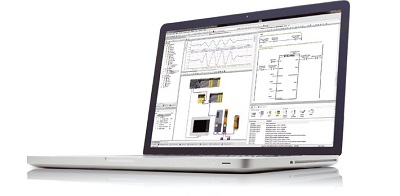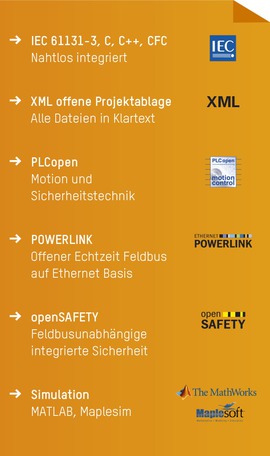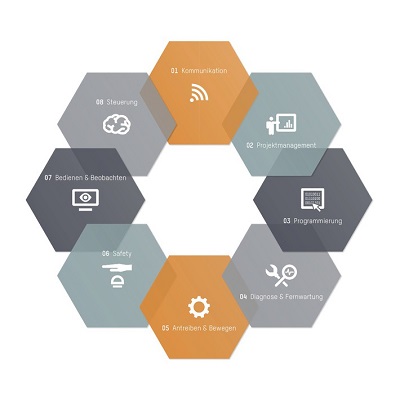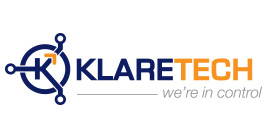Automation Studio 4
The single software tool from B&R automation

One tool
A single uniform programming tool for every aspect of an automation project minimizes training needs, solidifies overall integration and eliminates communication problems between engineering disciplines.
Reduce lead times
Accelerate time to market with automatic code generation from machine simulations, utilization of configuration data from electrical engineering software and efficient collaboration supported by breaking down software development tasks into modules.
Cut development costs
Save time and money by starting software development before the hardware is completed, reusing software modules across multiple projects, validating functionality via simulation and carrying out commissioning module by module.
Improve reusability
System-supported, fully graphical hardware configurations and software modularization at every level facilitate the development of machines and systems that take advantage of pre-programmed technology components.

Faster to market
Automation Studio 4 is the ultimate tool for machine and systems engineering. Through its sustainable and efficient approach to software development, it will help you keep your quality up, your engineering costs down and your time-to-market short – even in the face of ever-increasing product complexity.
The capital goods market expects continuously expanding functionality while keeping prices constant. It demands top quality, a long useful life and low operating and service costs. The only way for machines and systems to meet these requirements and offer real added value to the bottom line is through increased complexity. Increasing the time spent planning, developing and building these products is not an option since fierce competition is driving companies to gain a technological edge.
A paradigm shift towards success
Parallel engineering is one of the keys to accelerated development. This means starting software development as soon as the specifications are defined, simultaneously and hand-in-hand with the development of the mechanical and electrical components. It also means having multiple programmers working concurrently on various aspects of the overall software solution.
Another key to achieving ambitious development goals is reusing existing software elements that have already proven themselves in the field – whether modules developed in-house or pre-programmed technology components. This saves the time and effort that would otherwise be spent on programming, testing and certification.
As a single tool for machine and system automation, Automation Studio 4 delivers an unprecedented array of cutting-edge features to support every stage and aspect of product development. It empowers software developers to master the growing complexity of mechatronic systems – quickly, efficiently and without compromising quality.
Faster to learn
- Intuitive user guidance
- Consistent user interface for all aspects of an automation project
- Ready to use immediately
Faster to program
- Versatile programming in IEC 61131-3, C, C++ and CFC languages
- Scalable hardware platform with long-term availability
- Open standards and bidirectional interfaces
Faster service
- A single partner for control, HMI, motion and safety technology
- Comprehensive remote diagnostics
- Worldwide support
Integrated software engineering
Automation Studio 4 is the ultimate development and runtime environment for every aspect of an automation solution – from control and motion technology to HMI, operation and integrated safety technology. The 4th generation of this powerful software engineering platform for industrial automation has been completely redesigned to help users work more efficiently and effectively.
Today's software developers are confronted with an unprecedented diversity of hardware options, both on the machine and on their desks. To keep up with the mounting complexity, functional density and variety of tasks involved in each machine, development methods have been forced to evolve dramatically.
Time-to-market goals can no longer be achieved by waiting until the machine is built and the hardware is in place before rushing through software development under extreme time pressure. While today's programming tools are indeed able to accelerate the task of programming itself, the greatest potential for efficient and sustainable product development lies in merging the fields of mechanical, electrical and software engineering and treating machines and systems like the integrated creatures they really are.
The advantages of object-oriented programming
Object-Orientated
The behavior of a machine or system is governed by its software. It is the software that steers every process and movement, it is the software that manages vital messages and operating data, and it is the software that ensures appropriate responses to user input, instructions from 3rd-party systems and events reported to it via sensors.
Software development can therefore begin on the basis of the same specifications as the mechanical design, even when many details of the mechanical design are likely to change. The advantages offered by object-oriented programming can be leveraged to create structures and variables that can be filled in with actual values at a later stage.
Bidirectional data exchange with CAD systems
Automatic code generation from simulation models helps align the software with the mechanical design very early in the development process. Programming is further reduced by being able to create individual components or entire modules in advanced CAD software using data generated from simulating kinematic and dynamic systems.
When it comes to electrical planning, there are many benefits to avoiding the unnecessary effort and risk of errors associated with having two versions of the master data. Now, software developers can easily synchronize ECAD projects with the hardware configuration in Automation Studio using the EPLAN Electric P8 interface. This bidirectional exchange ensures that both sets of data are always up to date.
Sustainable savings through reusable modules
Integrated tools facilitate teamwork, while automated version management reduces the time spent on coordination and documentation. Helpful features such as automatic generation of master data, a visual hardware configuration tool and convenient object-oriented programming make designing software even more enjoyable.
Self-contained modules that exchange data via clearly defined interfaces instead of accessing global variables can be arranged into any conceivable hierarchy. Automation Studio makes it easy to divide an overall application into subprojects for multiple developers or to outsource individual software components. It grants you the agility to successively upgrade complex machines component by component without the hassle of having to completely reprogram them. A modular software architecture makes it easy to leverage the full potential of technology components and function libraries. Not only does this mean fewer hours spent writing and testing code, it also allows you to create dynamically configurable machine variants and optional features.
Open at every level
The only future-proof solution is an open solution. Openness allows you to work with the tools you are most comfortable using. It allows machines to communicate effortlessly with external systems. And by facilitating the reuse of existing software for future solutions, it frees up valuable time to get your product to market faster. Proprietary solutions, step aside. The future is Automation Studio 4.
Automation Studio 4 allows PLC programming in all IEC 61131-3 languages, in CFC and C, as well as object-oriented programming in C++. This not only allows programmers to work in their preferred language, it also means existing code can be easily integrated. The availability of PLCopen function blocks such as those for motion control and safety further simplifies programming, as do connectors for integrating code generated automatically from simulation tools.
Project files are shared exclusively in XML format, the de facto IT standard, which ensures open communication with third-party systems such as material management and production planning software. Further support is provided by direct access to databases via the SQL interface.
Many interfaces to other systems
Automation Studio 4 utilizes OPC Unified Architecture, or OPC UA for short, for its direct connection to the plant management level. This protocol provides convenient functions that make developers' lives easier, and as a recent market standard with an open architecture, it promises long-term compatibility with an extremely wide range of third-party systems. Automation Studio 4 also supports various Internet technologies through the use of dedicated libraries that streamline the implementation of location-independent approaches to operation and production.
With options for the direct integration of all fieldbus systems, Automation Studio 4 opens up the full spectrum of available field devices and provides optimal support for third-party system integration. Integrated safety solutions based on openSAFETY – also programmed in Automation Studio 4 – are completely independent of the fieldbus system being used.

Software engineering with Automation Studio
With Automation Studio, developers can program, test and optimize open and closed control loops and algorithms, movement sequences and visualization interfaces – all in a single development environment. This eliminates the problems that arise when interfacing between separate tools and significantly increases development efficiency. Through the use of open communication and software architectures and the application of modern, sustainable development techniques, this integrated development platform and real-time operating system supports time-saving development of high-quality complete solutions from start to finish. Eliminate barriers between systems and tap into the full potential of reusable software components with Automation Studio 4.



